Key takeaways:
- Hospital ministry bridges the gap between faith and healthcare, emphasizing holistic care that addresses emotional and spiritual needs along with physical ones.
- Hope plays a crucial role in the healing process, fostering resilience and encouraging active participation in treatment among patients.
- Common setbacks in hospital settings include miscommunication and patient turnover, which can hinder relationships and emotional support for both patients and caregivers.
- Sharing experiences of hope and personal affirmations can uplift individuals and create a sense of community support, enhancing resilience during challenging times.
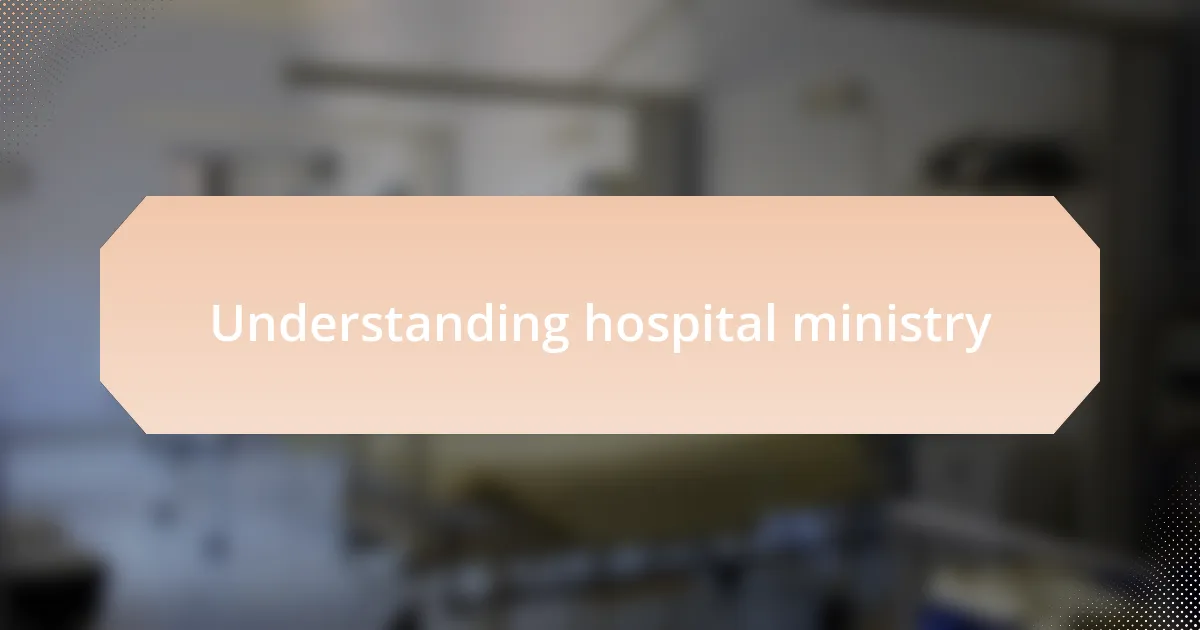
Understanding hospital ministry
Hospital ministry is a vital aspect of holistic healthcare, serving not just the medical needs of patients but also their spiritual and emotional well-being. I remember my first visit to a hospital as a minister, feeling the heavy atmosphere filled with uncertainty and fear. How do we, as caregivers, offer not just comfort but also hope in such an environment?
What intrigues me about hospital ministry is its unique role in bridging the gap between faith and health. It isn’t just about prayer; it’s about actively listening to patients, understanding their fears, and providing support during their darkest hours. I once spoke with a patient who felt utterly lost; just listening and sharing a moment of genuine connection changed everything for them.
In my experience, the beauty of hospital ministry lies in its simplicity—offering a word of encouragement, a touch of compassion, or even a quiet presence can bring light into the most daunting situations. It challenges me to reflect on how my own faith influences my ability to be present for others, igniting a desire to foster that sense of hope and resilience. How can we ensure that hope is always part of the healing journey?

Importance of hope in healing
Hope acts as a lifeline in the healing process, allowing patients to envision a future beyond their current struggles. I remember a patient who, after her diagnosis, felt trapped in a never-ending cycle of despair. Yet, when we talked about hope—how it can coexist with pain—she began to share her dreams of recovery, which sparked a transformation in her outlook and spirit.
The sheer power of hope can often be underestimated, especially in a hospital setting where fear and uncertainty can dominate. I’ve seen how an essential shift occurs when a patient embraces hope; it fuels their resilience, prompting them to engage more actively in their treatment. Isn’t it incredible how something as intangible as hope can lead to tangible improvements in health outcomes?
During my time in hospital ministry, I’ve often witnessed how hope brings communities together. I recall organizing small group sessions where patients shared their experiences. The energy shifted; as each person spoke about their hopes, it created a collective strength that was palpable. This sense of unity not only uplifted individual spirits but also fostered an environment where healing could truly flourish. How can we cultivate spaces where hope thrives together with care?
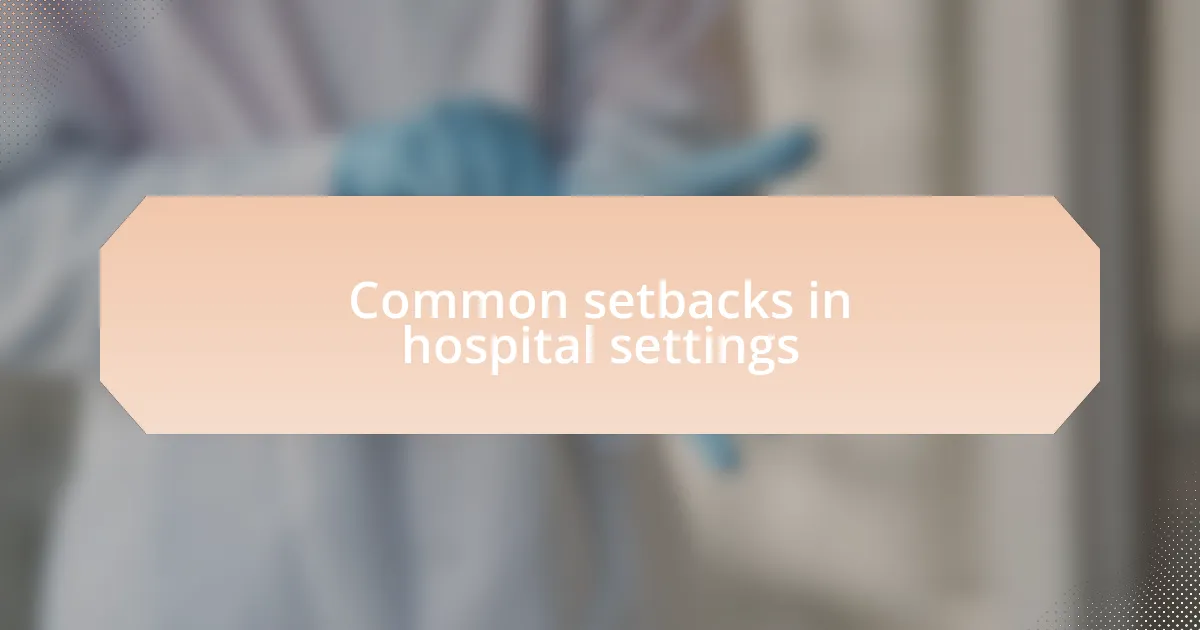
Common setbacks in hospital settings
Setbacks in hospital settings can manifest in various forms, often leaving both patients and caregivers feeling disheartened. For instance, when a treatment plan is adjusted or a patient’s progress stalls unexpectedly, it can evoke a sense of frustration and defeat. I remember speaking with a nurse who felt the weight of such moments; she often described how it pained her to see patients who were eager to heal suddenly face roadblocks. Have you ever felt that helplessness when you know your care is falling short?
Another common setback arises from miscommunication, creating hurdles that can amplify stress. I once experienced this firsthand during a family meeting regarding a patient’s prognosis. The mixed messages exchanged left the family more confused than informed, which negatively affected their ability to cope. It makes me wonder, how often do we overlook the importance of clear communication in alleviating anxiety and fostering hope?
Patient turnover can also be a setback, as the constant flux of individuals can lead to diminished community bonds. I’ve seen how quickly relationships form in hospital ministry, only to be disrupted when a beloved patient is discharged. There’s often an emotional ripple effect within the caregiver team as well. Isn’t it remarkable how our connections shape our experiences, even in the realm of healthcare? These setbacks remind us of the delicate balance required to maintain hope amidst the challenges we face.
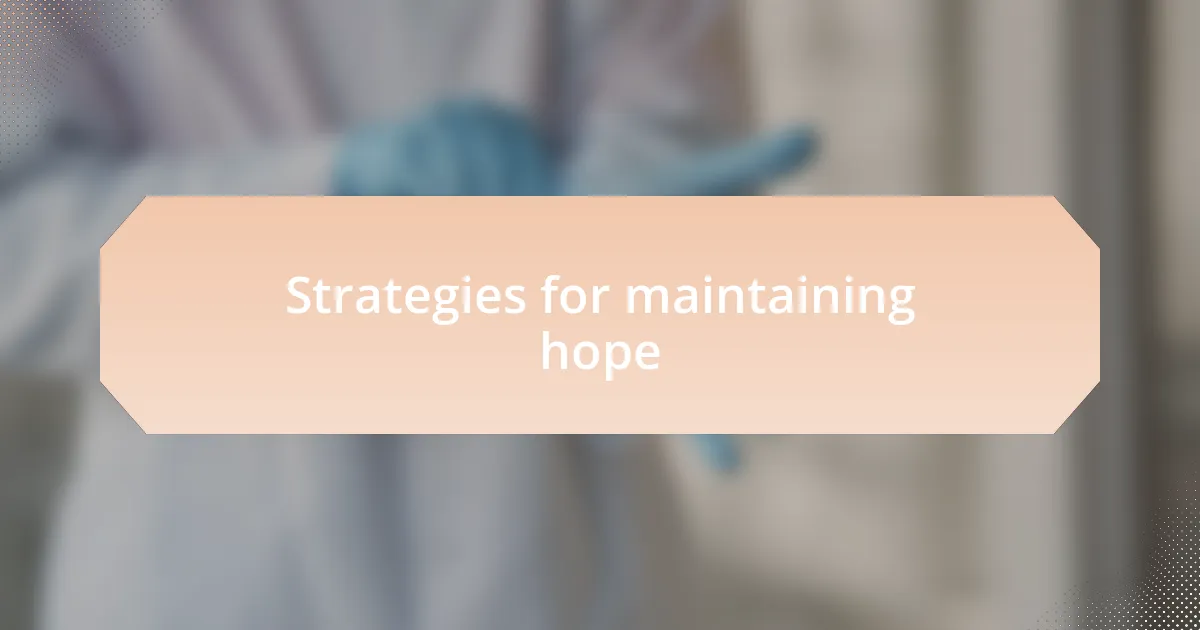
Strategies for maintaining hope
One effective strategy for maintaining hope during setbacks is to cultivate a support network. In my experience, sharing struggles with fellow caregivers can lighten the emotional load and provide fresh perspectives. Have you ever noticed how a simple conversation can shift your outlook? For me, those moments of camaraderie are vital; they remind me that I’m not alone in facing challenges.
Another approach is to focus on small, achievable goals. I’ve found that celebrating even minor successes, like a patient showing improvement in a small way, can rekindle hope. It’s fascinating how the act of recognizing progress, no matter how small, can fuel motivation for future endeavors. When was the last time you took a step back to appreciate the little victories in your work?
Lastly, practicing gratitude can significantly influence our outlook during tough times. I make it a habit to reflect on what I’m thankful for, even amidst chaos. This intentional shift in mindset helps me see the silver linings. Have you ever considered how a simple moment of gratitude can illuminate the path ahead? It’s a powerful reminder that hope often lies in the smallest of moments, waiting to be acknowledged.
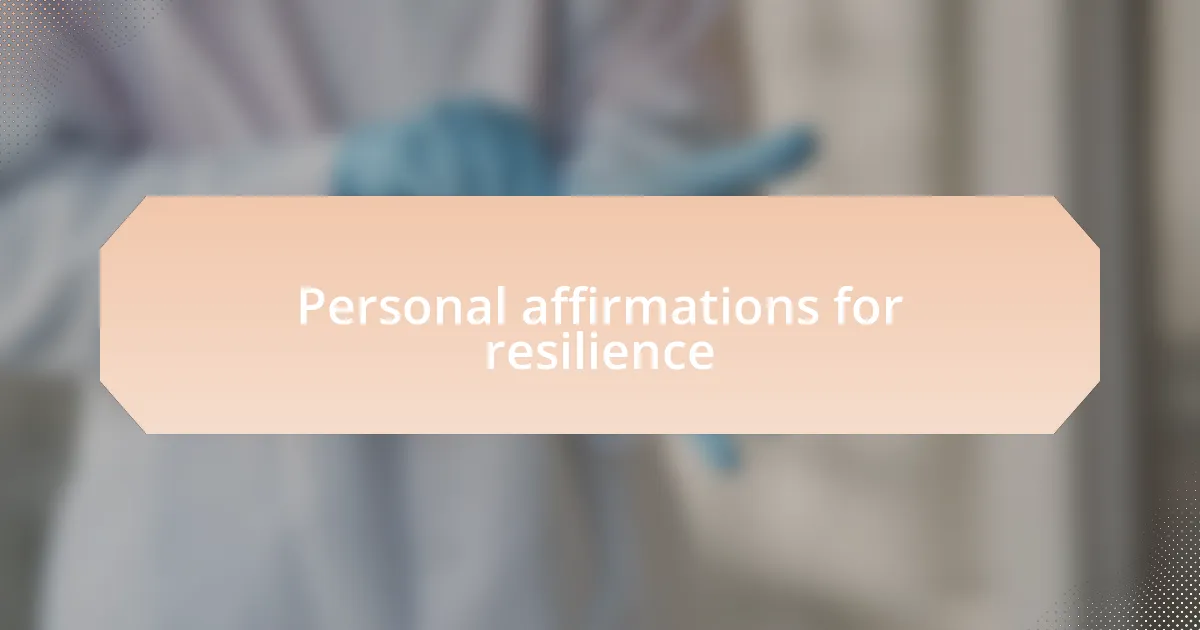
Personal affirmations for resilience
Personal affirmations play a crucial role in building resilience. When faced with setbacks, I often remind myself of my strengths and past achievements. It serves as a subtle nudge that challenges can be overcome; isn’t it empowering to acknowledge your own capabilities?
In one of my more challenging days, I crafted a simple affirmation: “I am strong, I am capable, and I bring comfort to others.” Repeating this to myself, especially in quiet moments, reinforced my sense of purpose. Have you ever tried creating your own mantra? It can transform despair into determination—it’s remarkable how words can reshape our reality.
I’ve also learned to incorporate affirmations into my daily routine. Each morning, I look in the mirror and set an intention with affirmations that resonate with my values. This practice not only centers me but also cultivates a mindset of hopefulness. How about reflecting on what you want to embody each day? It’s a practice that can gradually shift your perception and foster resilience in the face of adversity.
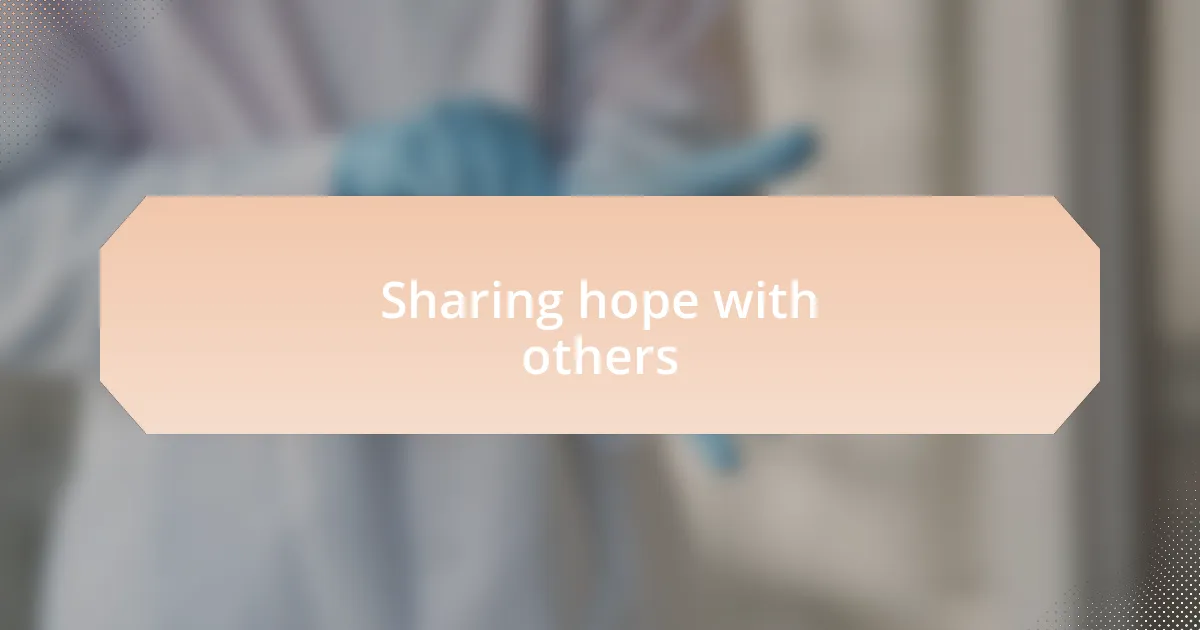
Sharing hope with others
Sharing hope with others is one of the most profound elements of community support. I remember a day at the hospital when a fellow volunteer shared her story of hope after battling a serious illness. Her resilience lit up the room and reminded us all that even in dire circumstances, sharing our journeys can uplift others. Have you ever had a conversation that changed your perspective entirely?
When I engage with patients or their families, I often encourage them to share their stories too. It’s incredible how a simple act of listening can create a ripple effect of hope. I’ve seen how one person’s triumph can inspire another to hold on just a little longer. Isn’t it comforting to know that your experiences might be the light someone else is seeking?
In group sessions, I’ve noticed that when individuals open up about their struggles and victories, there’s a palpable shift in energy. It’s as if hope multiplies in the shared space of vulnerability, and everyone leaves feeling a little lighter. Reflecting on these moments makes me realize that hope isn’t just an individual journey; it thrives collectively. What are ways you could cultivate this shared hope in your community?
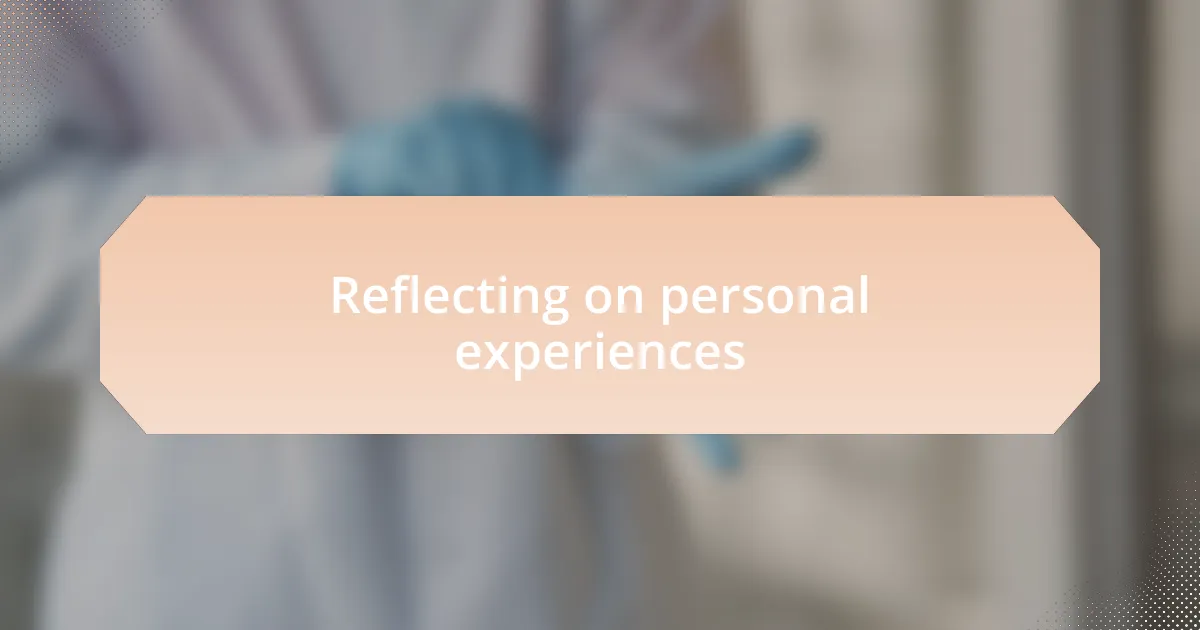
Reflecting on personal experiences
Reflecting on my experiences in hospital ministry brings vivid memories to mind. I recall a particularly tough day when I met a patient who felt lost and alone after a devastating diagnosis. As I sat with her, I shared my own journey of navigating personal challenges. In that moment, our hearts connected, and I witnessed how vulnerability can foster an unexpected sense of hope.
There was a time when I faced a setback myself, feeling overwhelmed by the weight of loss. I turned to the stories of those I had met in the hospital, remembering their courage. It struck me that reflection isn’t merely about recalling what happened; it’s about finding meaning in those moments. Have you ever looked back on a hardship and noticed how it led to personal growth? It’s a powerful realization that challenges can shape our resilience and deepen our empathy.
I often find that revisiting my own struggles leads me to greater compassion for others. Each story I recall serves as a reminder that setbacks can be transformative. I sometimes ask myself, “How did I find strength in those low times?” The answers often lie intertwined with the experiences of those I’ve served, illustrating that hope is a shared journey. Isn’t it fascinating how interconnected we all are through our stories?